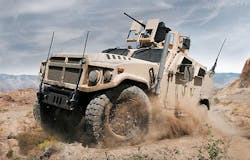Protest delays over: DOD plans to order 2,020 Joint Light Tactical Vehicles (JLTV) in 2017
Oshkosh won a $50 billion U.S. Army contract last August to build the U.S. military's next-generation light battlefield vehicle and associated vetronics to replace the venerable Humvee, in what is expected to be one of the most lucrative military vehicle programs over the next decade.
That contract has options that could increase its value to $6.7 billion. Production over the lifetime of the JLTV program is estimated at about $50 billion.
The program was held up for about six months, however, after losing contractor Lockheed Martin Corp. protested the contract decision. Now that protest has been settled, however, and DOD leaders and Oshkosh engineers are ready to ramp-up JLTV production in earnest.
The JLTV family of vehicles is a Joint U.S. Army, Marine Corps, and Special Operations Command program that provides vehicles and companion trailers to fill several mission roles while providing protected and networked mobility for warfighters and their equipment.
Related: Oshkosh prevails over AM General and Lockheed Martin to build JLTV armored combat vehicle
JLTV will use scalable armor to protect soldiers, Marines, and their equipment Military leaders and Oshkosh vehicle designers are emphasizing commonality of components, maintenance procedures, and training between all variants to keep costs down. The vehicle can be sling-loaded aboard Army CH-47D heavy-lift helicopters, as well as aboard Marine Corps CH-53E cargo helicopters.
story continues below
The JLTV has two variants: a two-seat combat support vehicle and a four-seat combat tactical vehicle. The two-seat variant has payload capacity for 5,100 pounds, while the four-seat version can carry 3,500 pounds of payload.
The fiscal 2017 DOD budget request of $725.4 million for the JLTV will pay for the third and final year of JLTV low-rate initial production, continues full-up system-level testing, and includes live-fire testing.
The vehicle can travel as fast as 70 miles per hour and as far as 300 miles between refuelings. Oshkosh is designing the vehicle to replace the military High Mobility Multipurpose Wheeled Vehicle (Humvee) with better protection and heavier payload.
The JLTV is based on the Oshkosh Light Combat Tactical All-Terrain Vehicle (L-ATV), which incorporates the company's Core1080 crew-protection system for warfighter survivability.
The JLTV provides under-vehicle protection from improvised explosive devices (IEDs) and other munitions similar to that of the Mine-Resistant Ambush Protected (MRAP).
The vehicle's weapons include turret-operated systems, remote weapons systems, and tube launched missiles. It can travel over hazardous terrain or unpaved roads, and features the L-ATV’s digitally controlled fuel-efficient engine and a power train that adapts to different operating conditions.
The vehicle's jam-resistant doors will allow the passengers to escape after the vehicle has taken damage. The JLTV will be equipped with a diagnostic monitoring system that will electronically alert the operator of equipment failures so that they can be fixed.
Its electronic monitoring will observe the fuel, air intake, engine, cooling, transmission, energy storage, power generation and vehicle speed as well as other systems.
Related: Army makes some of the last Humvee orders before JLTV contract is awarded later this year
The vehicle can continue operating temporarily after taking a small-caliber bullet-sized perforation to the fuel tank, engine oil reservoir, or coolant system, and can run on two flat tires.
The JLTV can operate at altitudes as high as 12,000 feet in temperatures from -40 to 125 degrees Fahrenheit. When temperatures drop below zero, the JLTV can start within one minute with no external aids, kits, or prior warming of the batteries.
It has a 25-foot turning radius and can climb 2-foot vertical obstacles in forward and reverse. In addition, the JLTV can drive off an 18-inch vertical step at 15 mph with no mechanical damage. JLTV is transportable by sea, rail, and air, including C-130 fixed-wing cargo aircraft.
For more information contact Oshkosh Defense online at http://oshkoshdefense.com.
